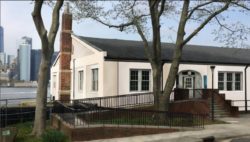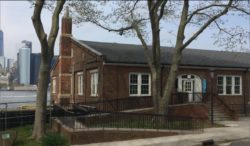
Rendering of proposed changes to Governors Island Building 110. Image Credit: LPC
In addition to re-facing to prevent further damage to the porous, water-damaged brick, work will aid expansion of tenant artists’ colony. On May 9, 2017, the Landmarks Preservation Commission approved an application by the Trust for Governors Island to reclad an 1870s building constructed as an ordnance storehouse in stucco, with other alterations. The 300-foot-long two-and-a-half story building is part of the Governors Island Historic District. The red brick Romanesque Revival storehouse served as office space for the military in the 20th Century, and currently hosts artists’ residences, as well as studio and exhibition space, operated by the Lower Manhattan Cultural Council. The Trust’s Matt Blood and architect Nancy Rankin of John G. Waite Associates presented the plan.
Blood said the building’s location near the north shore of the island and the heavy exposure to wind and salt water had cause severe degradation of the brick. He said that the building had been faced in stucco in the early 20th century, until removed as part of a Works Progress Administration restoration project in 1938. The applicants had discovered remnants of the historic stucco on the building, and planned to recreate its color and composition. The new lime-based stucco, custom-mixed on analysis of the historic sample, would be off-white in color.
According to Blood, the stucco would prevent any further water infiltration and deterioration to the brick, and the re-facing could be reversed if technology became available that that would allow for the protection of the exposed masonry.

Current condition of Governors Island Building 110. Image Credit: LPC
Blood testified that the brick was too far gone for repointing, that coating or painting would trap moisture in the brick, and that reconstruction of the facade in brick would entail the substantial loss of historic fabric. It is the only building in the district that the Trust plans to reface in stucco. Blood said neighboring structures did not exhibit the same degree of deterioration, and he believed a different type of brick was used on the storehouse. Sills and lintels would also be rehabilitated as part of project. The project is slated for completion in the spring of 2018.
The work will done concurrently with that of another application Landmarks approved on the same day for the construction of a handicapped access ramp at the main entrance, the removal of a chain-link fence, and upgrading of mechanical work. The work is part of the Cultural Council’s expansion within the building, which we will see the creation of more residential and exhibition space, as well as a café at the ground floor.
The Historic Districts Council’s Simeon Bankoff testified that the historic district’s ‘palette of brick’ speaks to its structures’ ‘purpose-built history and connection to one another.’ Bankoff urged Landmarks to mandate a “proper restoration” of the building’s facades. Christabel Gough, from the Society for the Architecture of the City, said the proposal erased the building’s color contrasts in way that was “quite unsympathetic,” and that while there might be a historic precedent for stucco, that did not mean it was not “ill-judged.”
Chair Meenakshi Srinivasan stated that Manhattan Community Board 1 had issued a resolution recommending approval of the application.
Commissioner Michael Devonshire stated that he had the opportunity to examine the building’s brick, which he said was among the worst he’d ever encountered, and likened to “little red sponges.” He said the applicants were “doing everything right” under the circumstances. Commissioner Michael Goldblum said it would possibly be aesthetically preferable to replace the damaged brick, but because there was historic evidence for stucco cladding, he was obligated to find it appropriate. Chair Srinivasan determined the proposed work served the long-term preservation of the building. She said the storehouse did not rank highly in the hierarchy of buildings that composed the district, and the stucco was appropriate for the more utilitarian structure.
LPC: Governors Island-Building 110, Governors Island Historic District (19-10524) (May 9, 2017) (Architect: John G. Waite Associates).
By: Jesse Denno (Jesse is a full-time staff writer at the Center for NYC Law).

